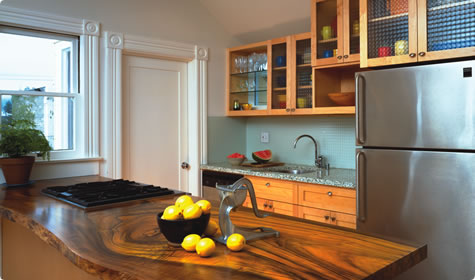 |
 |
 |
If you're thinking of replacing kitchen countertops and backsplashes, a vanity top, or a shower surround, you have many attractive, functional and green options to choose from. Recycled glass and ceramic tiles are available in a rainbow of colors. Other appealing options include terrazzo-like materials that blend recycled glass and concrete, richly grained butcher block fashioned from salvaged wood or bamboo, and even durable composite materials made from recycled paper.
Here are some pros and cons of various green countertop options:
-
Tile. Ceramic, porcelain and glass tile are classic choices for kitchen and bathroom countertops and backsplashes, as well as shower walls. From an environmental perspective, tile is a reasonable choice: Although it takes some energy and resources to manufacture it, it's made from relatively abundant natural materials and it can last for decades if properly installed.
You can do more good for the environment if you choose a tile product that contains recycled material. Today there's a wide selection of gorgeous recycled ceramic, glass and metal tiles to choose from.
When comparing recycled-content products, favor those that have a high post-consumer recycled content. Post-consumer material comes from the discarded bottles, cans, paper and other products that would wind up in landfills if we didn't recycle them, whereas post-industrial material is manufacturing scrap that goes back into the manufacturing process to make new products. Choosing products with post-industrial recycled content typically does not help reduce waste going to landfills or help support municipal recycling programs.
-
Quarried stone alternatives. Granite and other quarried stones have long been popular kitchen and bathroom surfacing materials, for good reason. Stone is beautiful, durable, water-resistant and about as natural as it gets. Unfortunately, quarrying it and shipping it around the world takes its toll on the environment. Green alternatives abound. Choose locally quarried stone, if that's an option. Or visit local used building material centers; many have large inventories of salvaged stone countertops.
Other green options include colorful terrazzo made from chips of polished recycled glass bound in a cement or resin matrix, and solid surfacing composite materials made from recycled paper.
-
Wood. Wood isn't suitable for locations that get wet, but it can be a good choice for some countertops such as kitchen islands, as well as shelves in kitchens, bathrooms and laundry areas. Green options include countertops made from wood salvaged from sources such as deconstructed warehouses and oak wine vats. Wood countertops are also available that have the Forest Stewardship Council (FSC) certification, a seal of approval that the wood came from sustainably managed forestry operations. Also consider bamboo, a fast-growing grass that some companies turn into countertops, tabletops and flooring as durable as many hardwoods.
Featured Products
The Green Product Directory features a number of beautiful, healthy and environmentally friendly countertop materials. We've highlighted a selection of products that meet one or more of these criteria:
- FSC-certified
- Made primarily from reclaimed or rapidly renewable materials
- Made with at least 25% post-consumer recycled content
Not all products are suitable for every countertop application. Consult with the countertop retailer about recommended uses, as well as installation and maintenance guidelines.
More countertop tips
- Fix it up. Before tearing out an old countertop, evaluate your options for sprucing it up or repairing it. Reusing what you've got saves energy, natural resources and water compared to buying newly manufactured products. It can save you money too. If tiles look grungy because of cracked or stained grout, you can repair the grout yourself or hire a tile contractor. Wood countertops can be sanded and resealed.
- Pass it on. If the kitchen counter or vanity top has to go, is it in good enough shape that you can use it in another part of your home, such as a laundry room, work room or garage? If you can't use it, consider selling or donating it to someone who could make good use of it. Keeping usable materials out of the landfill preserves natural resources and helps keep home improvement affordable.
- Buy local. Products fabricated locally (preferably from locally harvested or locally manufactured materials) offer many environmental, economic and social benefits such as helping keep jobs in your community and reducing transportation energy use.
- Make it last. Choose durable products and installation methods. These may cost a little more upfront or require a bit more time to install, but they will reduce your long-term maintenance, repair and replacement costs. And durable products and materials typically don't get sent to the landfill as often as their lower quality counterparts.